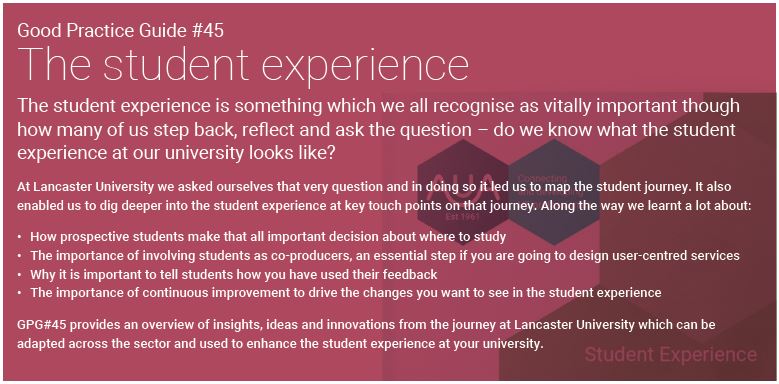Students as change agents

Jean Mutton FAUA | Director, Go Process Design LtdClare Foyle MAUA | Deputy Director of Planning, Coventry University
The race for the best possible student experience is becoming increasingly important for universities. Recent Government policy changes have further reinforced the marketisation of the sector and student satisfaction remains a key driver, particularly with the inclusion of National Student Survey measures in the Teaching Excellence Framework.
At the 2017 AUA Conference in Manchester we led a session on this topic. At the start, delegates were asked to capture on sticky notes all the different ways their institution engaged with students to help enable them to understand the student journey. We then asked them to sort their thoughts into three categories, which we then presented as a model of increasing student engagement: consultation, collaboration and co-production.
Consultation is often carried out by means of surveys or focus groups. They reach high numbers ofstudents, leading to large datasets and are relatively quick and cost effective. However, the specificity of the questions limits the depth of analysis that is possible and can be skewed by the point in time at which the consultation takes place. For example, what students say about the library opening hours at the start of a semester may be very different to what they say immediately prior to exams.
Collaboration usually involves students in improving existing processes or projects; for example, they may be asked to join a project board or participate in a periodic review. This allows students to influence processes that impact directly upon them. However, it can be difficult to engage students in an already established project and the amount of influence they might have can be limited.
Co-production is a way of engaging students as equals, where they define the terms of their engagement and the role they are playing, leading to a deeper understanding of the student experience. Co-production also develops a sense of belonging in students which can impact on retention and attainment. We shared examples of successful co-production projects, which involved innovative ways of engaging with students, such as video diaries, shadowing, storyboarding and prototyping. Often, the process or project had to be
redefined from the student’s perspective and the service aim was fundamentally changed.
One example we gave was when a senior manager had decided to throw a lot of resources at ‘busting the queues’ at enrolment. However, the students turning up at the empty desks to enroll were asking “Am I the only one on this course”? Making friends is an important way to feel settled at university in the early days, and one opportunity to meet and chat with other new students had been, unwittingly, taken away.
The concept of students as catalysts for change is already apparent in the world of teaching and learning. Pioneers such as Mike Neary at the University of Lincoln1 have demonstrated the benefits of working with students as co-producers of their learning experience. The ‘Students
as Producers’ project2 helped to establish a framework for staff to engage with students on curriculum design and development, and is now fully embedded into the university.
The increasing importance placed on student engagement is reflected by the establishment of networks for staff, associated practitioners and students involved in this work. The RAISE network
(Researching, Advancing and Inspiring Student Engagement)3 has as one of its special interest groups ‘Students as Partners’.
In the session, delegates discussed how co-production methodologies differ from standard project and programme designs. Most projects start with a plan, which is executed step by step to reach a solution. We suggested that stepping back and engaging with end-users to understand and define a vision prior to deciding what to deliver (and working with them interactively) shapes and defines a better outcome.
The depth of understanding of the student experience increases from consultation, to collaboration and co-production. However, the number of students it is possible to engage decreases, as shown below.

One way to help staff understand the student journey is to develop a set of imaginary personae to complement co-production techniques; in our session delegates had a go at ‘fleshing out’ a description of a student. We talked about how personae can be used to represent those harder-to-reach students, and to test out a project or process from the specific point of view of this individual.
Staff working in professional services run myriad systems and processes across the student lifecycle, from prospective students to alumni. However, there may be limited direct contact with students. Considering co-production techniques and the development of personae helps staff to develop an empathetic understanding of students, the pressures they face and their expectations. The more that these techniques can be used to bring staff and students together, the better the services we deliver will be.
References
1 studentasproducer.lincoln.ac.uk [accessed 27 April 2017]
2 heacademy.ac.uk/system/files/projects/lincoln_ntfs_2010_project_final_report_fv.pdf
[accessed 27 April 2017].
3 raise-network.com/get-involved/special-interest-groups-sigs/ [accessed 27 April 2017].


0 comments on “Students as change agents”